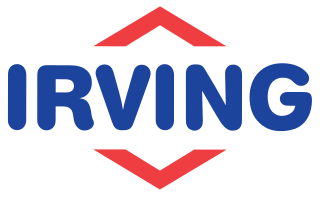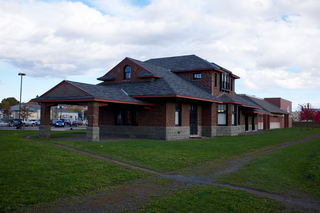In all modern states, a portion of land is held by central or local governments. This is called public land, state land, or Crown land. The system of tenure of public land, and the terminology used, varies between countries. The following examples illustrate some of the range.
Kenneth Colin Irving, was a Canadian businessman whose business began with a family sawmill in Bouctouche, New Brunswick, in 1882. In 1989, he was made an Officer of the Order of Canada.

Irving Oil Ltd. is a Canadian privately-owned intergenerational gasoline, oil, and natural gas producing and exporting company, a subsidiary of the parent company Irving Group of Companies,—one of the largest "private conglomerates" in North America. Irving Oil was one established in 1924 by Canadian oil baron and billionaire, Kenneth "K.C." Irving, whose family fortune when he died in 1992 was estimated by Forbes at USD$5 billion. His son, Arthur, became chairman and president of Irving Oil.

The Restigouche River is a river that flows across the northwestern part of the province of New Brunswick and the southeastern part of Quebec.
The New Brunswick Railway Company Limited (NBR) is currently a Canadian non-operating railway and land holding company headquartered in Saint John, New Brunswick that is part of Irving Transportation Services, a division within the J.D. Irving Limited (JDI) industrial conglomerate. It is not to be confused with another JDI company, New Brunswick Southern Railway (NBSR), established in 1995, which is an operational railway and considered a sister company of the NBR.

J.D. Irving Limited (JDI) is a privately owned conglomerate company headquartered in Saint John, New Brunswick, Canada. It is a subsidiary of the parent company, Irving Group of Companies, along with Irving Oil Refinery, Canaport, Irving Tissue Irving Equipment, Kent Building Supplies, New Brunswick Railway, New Brunswick Southern Railway, Eastern Maine Railway, Maine Northern Railway, Brunswick News, Acadia Broadcasting, Irving Shipbuilding, Cavendish Farms. It is involved in many industries including forestry, forestry products, agriculture, food processing, transportation, and shipbuilding. JDI company forms, with Irving Oil, Ocean Capital Investments and Brunswick News, the bulk of the Irving Group of Companies, which groups the interests of the Irving family.
Dalhousie is a former town located in Northern New Brunswick. On January 1, 2023, Dalhousie merged with the village of Charlo and all or part of five local service districts (LSDs) to form the new town of Heron Bay, named Baie-des-Hérons in French. Heron Bay is New Brunswick's northernmost point of land.

Alexander "Boss" Gibson was a Canadian industrialist in New Brunswick, Canada. His business interests included sawmills, railways, and a cotton mill. He founded the company town of Marysville, New Brunswick.

Atholville is a community in Restigouche County, New Brunswick, Canada. It held village status prior to 2023 but is now part of the city of Campbellton.

Harvey is a community in York County, in the Canadian province of New Brunswick, formerly an incorporated village but now part of an incorporated rural community of the same name. It is often called Harvey Station.

Tide Head is a community in Campbellton, New Brunswick, Canada. It held village status prior to 2023.

The Telegraph-Journal is a daily newspaper published in Saint John, New Brunswick, Canada. It serves as both a provincial daily and as a local newspaper for Saint John. The newspaper is published by Brunswick News. The Telegraph-Journal is the only New Brunswick-based English-language newspaper to be distributed province-wide, and has the highest readership in the province at a weekly circulation of 233,549 and a daily readership of about 100,000.
The North Western Coal and Navigation Company, also known as Alberta Railway and Coal Company or Alberta Railway and Irrigation Company, was a coal mining company formed in London, England in 1882 by Sir Alexander Tilloch Galt, one of Canada's Fathers of Confederation. As part of his vision for Canada, Galt was committed to finding industries that would bring settlers to the District of Alberta of the Northwest Territories. The company was founded to create a coal mining industry that could bring settlers to the Northwest Territories. It was based in Lethbridge, Alberta, with his son Elliott Torrance Galt, managing day-to-day operations. The company's superintendent was William Stafford. Money for this company came from a consortium of investors from Canada, England, and the United States.
Brunswick News Inc. is a Canadian newspaper publishing company based on Bloor Street in Toronto. Once privately owned by James K. Irving and based in Saint John, New Brunswick, it was sold to Postmedia in 2022.

The Fredericton station, also known as York Street station is a former Canadian Pacific Railway station located on York Street in Fredericton, New Brunswick, Canada.
Hodel v. Irving, 481 U.S. 704 (1987), is a case in which the U.S. Supreme Court held that a statute ordering the escheat of fractional interests in real property which had been bequeathed to members of the Oglala Sioux tribe was an unconstitutional taking which required just compensation.
The Lehigh Coal and Navigation Company (LCAN) (1988–2010) was a modern-day anthracite coal mining company headquartered in Pottsville, Pennsylvania. It acquired many properties and relaunched the Lehigh Coal Companies brand in 1988. The LCAN ran strip mining operations in the Panther Creek Valley east of Lansford, Pennsylvania along U.S. Route 209 with vast properties dominating the coal areas of Tamaqua, Coaldale, and Lansford.

Drummond is a civil parish in Victoria County, New Brunswick, Canada.
The Irving Group of Companies is an informal name given to those companies owned and controlled by the descendants of Canadian industrialist K.C. Irving, namely his children J.K., Arthur, and Jack (1932–2010) and their respective children.
Madawaska Maliseet First Nation or St. Basile 10 band is one of six Wolastoqiyik or Maliseet Nations on the Saint John River in Canada. The Madawaska Maliseet First Nation (MMFN) territory is in Northern New Brunswick. The MMFN reserve is located 1.6 km east of Edmundston in the north-western region of New Brunswick. The band membership has 350 people. About 114 members of the MMFN live on the St. Basile no. 10 reserve. They are part of the Saint John River Valley Tribal Council. Family names include Bernard, Cimon, Francis, and Wallace.










